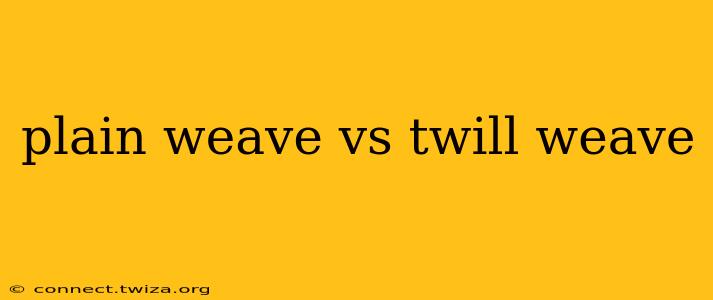Understanding the difference between plain weave and twill weave is crucial for anyone interested in textiles, sewing, or fashion. These two fundamental weave structures significantly impact a fabric's appearance, drape, durability, and overall feel. This guide delves into the intricacies of each, highlighting their key characteristics and applications.
What is Plain Weave?
Plain weave, also known as tabby weave, is the simplest and most basic fabric construction. It's created by interlacing one warp thread (running lengthwise) over one weft thread (running crosswise), and then under the next. This creates a simple, repetitive pattern. Think of a checkerboard – that's essentially what a plain weave looks like on a microscopic level.
Characteristics of Plain Weave:
- Appearance: Has a very simple, even, and balanced appearance. The warp and weft threads are equally prominent.
- Drape: Can range from crisp and stiff (like linen) to soft and drapey (like some cotton fabrics), depending on the fiber used.
- Durability: Moderately durable; it can be prone to snagging or tearing if the fibers are weak.
- Texture: Can feel smooth or slightly rough, depending on the fiber and finishing processes.
- Examples: Calico, muslin, chambray, some cotton broadcloths.
What is Twill Weave?
Twill weave is characterized by its diagonal lines or ribs. It's created by passing the weft thread over two or more warp threads, then under one, creating a diagonal pattern that shifts with each row. This "float" of the weft thread over multiple warp threads is what creates the characteristic diagonal. The number of warp threads the weft floats over determines the steepness of the twill.
Characteristics of Twill Weave:
- Appearance: Shows distinctive diagonal lines or ribs.
- Drape: Generally has a better drape than plain weave, often softer and more pliable.
- Durability: More durable than plain weave because the interwoven threads create a stronger structure. It resists snags and tears better.
- Texture: Can feel smooth or slightly textured depending on the fiber and finishing.
- Examples: Denim, gabardine, herringbone, twill, serge.
Plain Weave vs. Twill Weave: A Side-by-Side Comparison
| Feature | Plain Weave | Twill Weave |
|---|---|---|
| Construction | One warp over one weft | Weft floats over two or more warp threads |
| Appearance | Even, balanced | Diagonal lines or ribs |
| Drape | Varies, can be crisp or drapey | Generally good drape |
| Durability | Moderate | High |
| Texture | Smooth to slightly rough | Smooth to slightly textured |
| Examples | Calico, muslin, chambray | Denim, gabardine, herringbone |
How are Plain Weave and Twill Weave Used?
The choice between plain weave and twill weave depends heavily on the intended use of the fabric.
-
Plain Weave: Often used for everyday garments, bedding, and simple home textiles where affordability and breathability are important. Its simplicity allows for easy dyeing and printing.
-
Twill Weave: Frequently used for more durable clothing items like trousers, jackets, and outerwear. The diagonal weave provides strength and a slightly more luxurious feel.
What are the advantages and disadvantages of each weave?
Plain Weave:
Advantages: Simple to produce, breathable, inexpensive, easy to dye and print.
Disadvantages: Less durable than twill, prone to wrinkles, less luxurious feel.
Twill Weave:
Advantages: Durable, good drape, more luxurious feel, resists wrinkles better.
Disadvantages: More complex and expensive to produce, can be less breathable than plain weave.
What is the difference in weight and thickness between plain weave and twill weave fabrics?
The weight and thickness aren't inherently determined by the weave structure itself, but rather by the type and density of the yarn used. A tightly woven plain weave can be heavier and thicker than a loosely woven twill weave, and vice-versa. The fiber itself also plays a significant role; a heavy wool twill will be much thicker than a lightweight cotton plain weave.
Which weave is better for certain garments or applications?
The "better" weave depends entirely on the desired properties of the final product. For example, a lightweight cotton plain weave is perfect for a summer dress, while a heavy denim twill is ideal for durable jeans. There's no universally superior weave; each has its strengths and weaknesses.
This comprehensive guide helps illustrate the key differences between plain weave and twill weave. Understanding these distinctions allows for a more informed choice when selecting fabrics for various projects.
